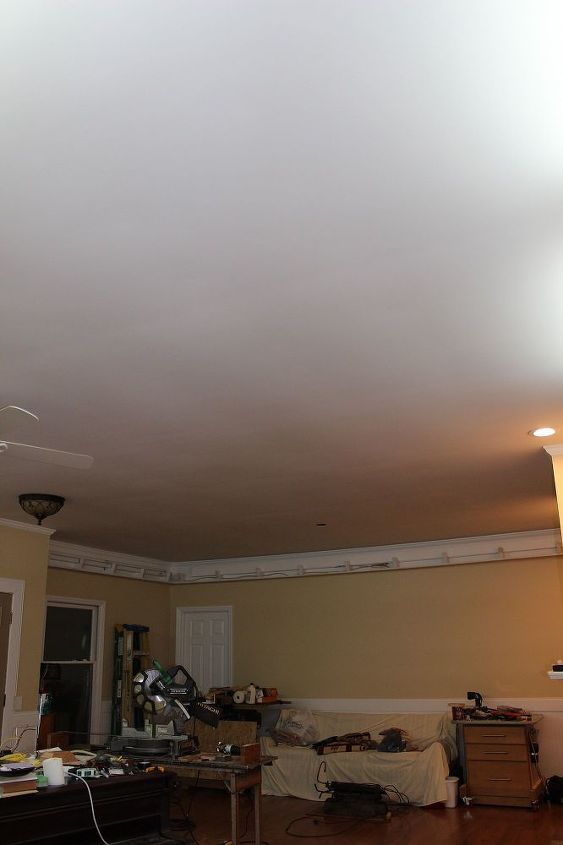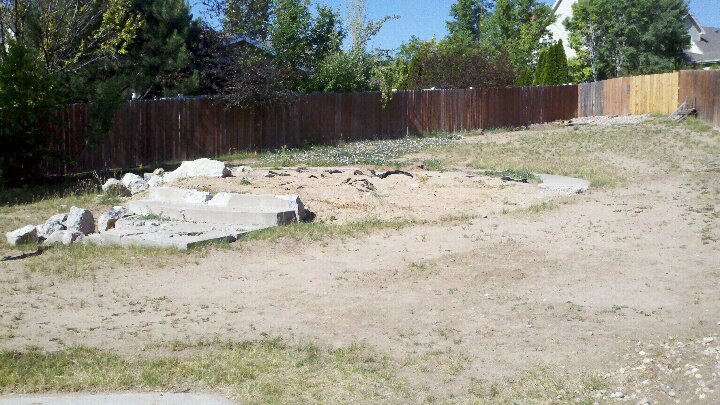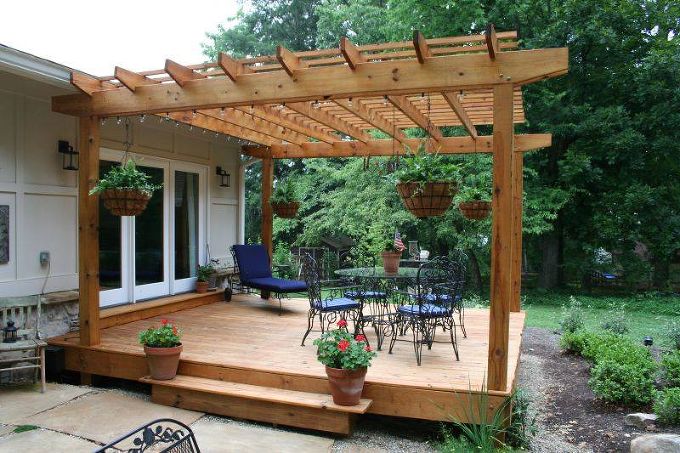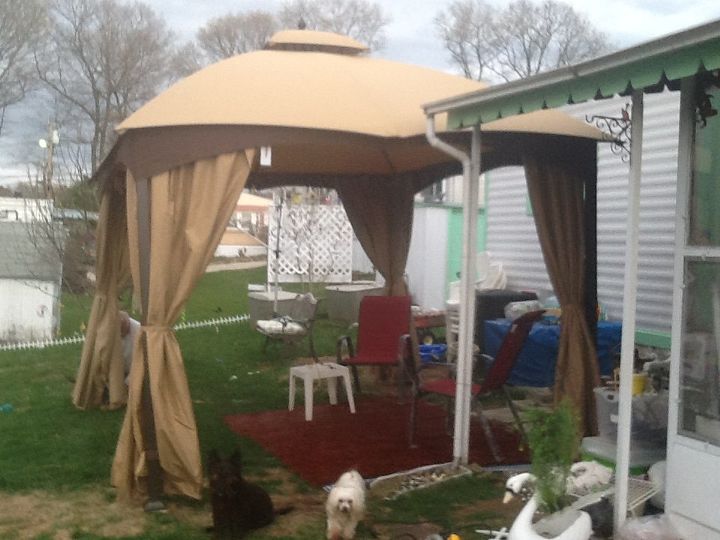Step?
I have a wood step that is about 3 " high & 2X3. Just a small one to step off my deck. But after years, it's beginning to rot away & it needs to be easy to make because I'm a senior & will be doing it myself. Don't get me wrong, I love little projects like this to do I have in the yard, some bricks (15) & a few cement cinder blocks. Anyone have any ideas how I can make some kind of a step for my deck. Thank you ! .........Madeline
Related Discussions
What to do with our livingroom ceiling?
We took the old popcorn ceiling off in our livingroom and thought we could just paint it. We fixed some hairline cracks where the joint in the sheetrock are, primed a... See more
Cheapest way to make a large retaining wall
I have almost 1/3 of an acre backyard that I will be re-establishing soon, and one of the projects will be a 2-3 ft tall retaining wall that will be approx. 25 feet ... See more
I am looking for someone to build me a pergola
I have a cement patio and want to have someone with experience build a pergola with a deck over the patio. I have a picture of just the one I would like that I found ... See more
How can I repair a rip in my canvas gazebo?
I have a 10x12 gazebo bolted to my deck. It is domed so it is very tall. I was trying to take the top down this Fall and accidentally ripped a hole in the canvas. Th... See more
Would it look right to put an outdoor kitchen under screened pool?
I just moved into this house coming from a house in the country from lots of land; so this type of home is very new to me. It's a typical Florida home with a screened... See more
Sandbags for landscaping
Has anyone ever used sand bags to border a driveway or flower bed ? We are buying a place in the woods with no sidewalks ( yet ), no paved drive way ( yet ). I was ... See more







I am not sure it would be a safe step if you used bricks and cinder blocks Madeline. Is it just the top wood that is rotting? Maybe you could just replace those boards using green treated lumber. Is there a stair stringer that is also rotting? Give us a bit more information or even a picture to get some good solutions.
How to build some simple and cheap wooden steps.
https://www.laspilitas.com/garden/howto/simple-steps.htm
Pavers are another alternative to concrete steps that are affordable and easy to work with. They come in a variety of sizes, shapes and colors, so you have many design options. Like stone, brick or concrete, they are highly durable and require little maintenance. In addition to cleaning them occasionally, you should seal them yearly to maintain their non-slip surface. A masonry adhesive is usually used to bond the pavers together to form the steps, but you'll also need to add a concrete base to serve as a bed for the steps. You can hire a mason to handle the project, but pavers are one of the more do-it-yourself friendly alternatives to concrete.
Building brick steps can be somewhat complex, though, so if you don't have much masonry experience, hire a professional. You'll likely need to pour a concrete pad and build a base with concrete blocks before mortaring the bricks on top. Like stone and concrete, brick steps require little maintenance beyond regular cleaning to keep them free of dirt and debris.
Hi! Can you use the old step as a template? Most places that sell lumber will make cuts for you. I would use pressure treated lumber. Good luck!
You might just be able to replace the top wood pieces which should be simple. Ask Home Depot to cut them to the right size and the you just have to nail it in
Bricks and cinder blocks would need a solid base and be mortared to hold them together.
You can build a simple deck step out of pressure treated wood
https://www.youtube.com/watch?v=4AxTdGb5kgY
Hi Madeline. Take the step apart. Label the pieces by writing on them with a pencil. You can make a new step by using the old step as a pattern. Use pressure treated lumbar and deck screws to make a new step.
Madeline
If you are talking about a wood framed step, replacing just the tread may be the way to go. But I don't think that is what you meant, given the dementions you've listed.
William is right that bricks would need mortar, but he may be too quick to rule out cinder block.
Measure what you have, but I can ballpark an idea for you.
Let's say that you have cinder blocks that are 8"high × 8"wide × 16"long & that your old step was 3"high × 36"wide × 24"long. If you have 9 blocks, you can do this up with a new handrail on either side & not loose an inch of tread.
Take your time and dig a hole where your old step was. You want it roughly 6" deep × 49"across × 25" front-to-back. Save about a third of the dirt, you can use it for backfill later. This is the hardest part for you. It might be worth asking the neighbors if anyone has a teen in need of a few dollars (or an attitude adjustment)
Next, tamp down the inside of the hole to firm it up. The local hardware store may have a manual tamper to rent (not the motor 1, the hole is too small). But it basically amounts to dropping something heavy, picking it up, & repeating. A 5 pound hand weight would get the job done if you don't mind sitting there a while. It doesn't need to be perfect. The tool I recommend amounts to a weight at the bottom of a 5 foot pole so you can do the job standing up straight as that is much easier on your back.
Lay down a layer of weed block fabric to keep grass & weeds, well, out. Add about 2" of sand to the hole. (2×49×25÷12^3 is roughly 1.5 cubic feet for your supply list) Tamp it again.
Lay out your cinder blocks gaps up, you will be filling them later. 3 with their long sides against your deck to give you 48" across, then place the other 6 perpendicular. 8" +16" gives you 24" front to back. You want them as close together as you can manage, but perfect is not required. Push them gently into the sand with a bit of wiggle & shimmy. Then breakout your spirit level. Get the bubble centered, but you shouldn't need to go more than 1/2" into the sand.
Next, place the supports for your hand rails in the gaps of your outer corners. That's 2 against your deck & 2 out into your yard. You want to use pressure treated 4"×4" lumber. I recommend painting or staining to match your deck, but for now, this is just a dry fit. You probably want the posts against the deck cut to 50" ish and the yard side at 40" ish, but a lot of that is preference. Your local hardware store can precut those for you. As you dry fit your posts, look at the railing of your deck itself. Ideally you will tie the new deck-side support posts to the deck rails with long bolts. Figure out where the seem to fit best, mark them, & pre-drill with the post out of the cinder blocks again. You also want to mark both the deck-side & yard-side posts for where you will attach the actual handrails. Pre-drill those.
Your choice for handrail could be as simple as 2"×2" lumber or as sturdy as a handicap grab bar. Obviously there are lots of options. Consider your needs as you age in place.
Paint or stain the posts & your tread board. (You will want to get that the same time as your posts & it should also be pressure treated. With my plan, you want that to be 24"×36")
With the exception of the 4 outside corners where the posts go, fill the insides of your cinder blocks loosely with dirt then press it down. Keep adding dirt until they are about 2/3 full even after pressing. Then top them off with cheap pea gravel. (Two 5 pound bags should be plenty. Increasing the effective mass of the blocks this way increases inertia, reducing movement. If you don't reuse your dirt, using more pea gravel is more stable & better drainage, but the dirt is free.)
Put the posts back into their spaces. Bolt the deck-side posts to the deck, then attack your chosen handrails. If there are gaps between the posts and cinder blocks, fill in with more gravel. Any remaining gravel can go in the 1/2" gap all around the cinder blocks.
Lastly, lay your tread board on top of the cinder blocks & screw it to the posts.
The blocks on the outside corners are now locked in place by the wood & the inner cinder blocks. The inner cinder blocks can't move away from the outer ones. & Your wooden elements aren't sitting in standing water every time it rains or snows.
I would for sure take it a part and trace sizes on the new material and put it together
Hi there,
Lay the Cinder Blocks in the shape of the step on a flat piece of ground. That should do it! Make sure they are all lined up straight and you don't have any gaps!
Just lay 4 cinderblocks on there side next to each other and that should work
Have you considered brick? It wouldn't rot, you could easily dig that size area out so its nice and level.
If it’s only 3” high and it needs to remain that height, then recessing the cinder blocks will keep them “penned” in place
or you can build a treated 2x4 lumber box or pen for the bricks and stake the box into place.
You could repeat the same step if you’d like. Most home improvement stores will cut wood to size for you so you’d only have assembly to do. Make sure you get outdoor rated wood.
Here's a video that might help - https://www.youtube.com/watch?v=4AxTdGb5kgY